Using Old Newspapers to Reconstruct an Ancestor’s Story – Podcast Episode 268
Listen to Genealogy Gems Podcast Episode 268
Episode Show Notes
Get 20% off Newspapers.com. Click here and use coupon code genealogygems
Visit Fort Wayne
Fort Wayne, Indiana is the home of the second largest free genealogy library in the country. Make your plans to visit today. Learn more at https://www.visitfortwayne.com
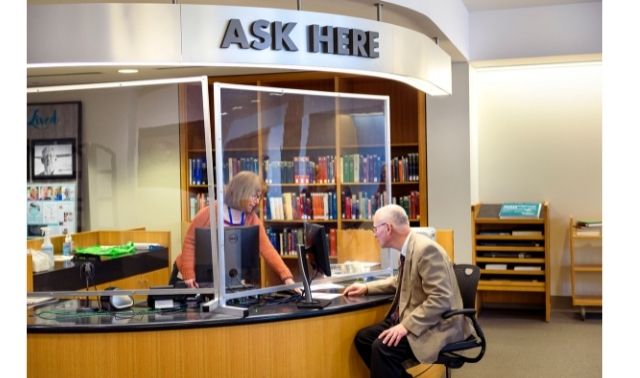
Learn more about the free genealogy resources at VisitFortWayne.com
Become a Genealogy Gems Premium Member
Premium Members have exclusive access to:
- Video classes and downloadable handouts
- The Genealogy Gems Premium Podcast
- Downloadable ad-free show notes PDF handouts
Become a member here.
Genealogy Gems Podcast App
Don’t miss the Bonus audio for this episode. In the app, tap the gift box icon just under the media player. Get the app.
Get the Free Genealogy Gems Newsletter
The Genealogy Gems email newsletter is the best way to stay informed about what’s available with your Premium eLearning Membership. Sign up today.
Follow Lisa and Genealogy Gems on Social Media:
How Artificial Intelligence AI and Machine Learning Impact Genealogy
Artificial Intelligence and Genealogy
Elevenses with Lisa Episode 32
In this episode we tackle a few small geeky tech questions about artificial intelligence, better known as AI, that may have a pretty big impact on your genealogy life. Questions like:
- Is artificial intelligence the same thing as machine learning?
And if not how are they related? - And am I using AI, maybe without even being aware of it?
- And what impact is AI really having on our lives? Is it all good, or are there some pitfalls we need to know about?
We’re going to approach these with a focus on family history, but pretty quickly I think we’ll discover it’s a much more far-reaching subject. And that means this episode is for everyone.
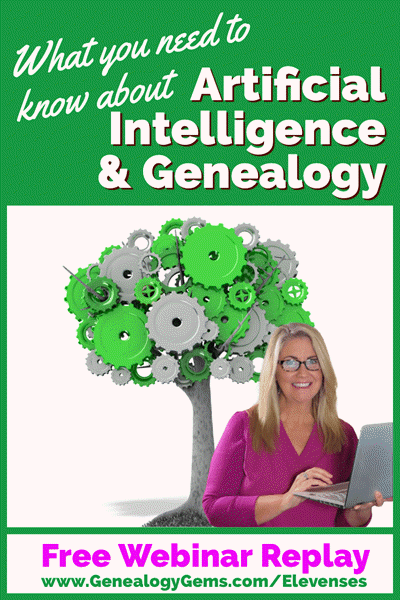
Watch the free video below.
While I’ve done my own homework on this subject and written about it in my book The Genealogist’s Google Toolbox, I’m smart enough to call in an expert in the field. So, my special guest is Benjamin Lee. He is the developer of the Newspaper Navigator, the new free tool that uses artificial intelligence to help you find and extract images from the free historical newspaper collection at The Library of Congress’ Chronicling America. I covered Newspaper Navigator extensively in Elevenses with Lisa episode 26.
Ben is a 2020 Innovator-in-Residence at the Library of Congress, as well as a third year Ph.D. Student in the Paul G. Allen School for Computer Science & Engineering at the University of Washington, where he studies human-AI interaction with his advisor, Professor Daniel Weld.
He graduated from Harvard College in 2017 and has served as the inaugural Digital Humanities Associate Fellow at the United States Holocaust Memorial Museum, as well as a Visiting Fellow in Harvard’s History Department. And currently he’s a National Science Foundation Graduate Research Fellow.
Thank you so much to Ben Lee for a really interesting discussion and for making Newspaper Navigator available to researchers. I am really looking forward to hearing from him about his future updates and improvements.
Artificial Intelligence and Genealogy
Covering technology and its application to genealogy is always a bit of a double-edged sword. It can be exciting and helpful, and also problematic in its invasiveness.
Tools like family tree hints, the Newspaper Navigator and Google Lens (learn more about that in Elevenses with Lisa episode 27) all have a lot to offer our genealogy research. But on a personal level, you may be concerned about the long reaching effects of artificial intelligence on the future, and most importantly your descendants. In today’s deeply concerning cancel culture and online censorship, AI can seriously impact our privacy, security and even our freedom.
As I did my research for this episode I discovered a few things. Artificial Intelligence and machine learning is having the same kind of massive and disrupting impact that DNA has had on genealogy, with almost none of the same publicity. (For background on DNA data usage, listen to Genealogy Gems Podcast episode 217. That episode covers the use of DNA in criminal cases and how our data potentially has wide-reaching appeal to many other entities and industries.)
A quick search of artificial intelligence ancestry.com in Google Patents reveals that work continues on ways to apply AI to DNA and genealogy. (See image below)
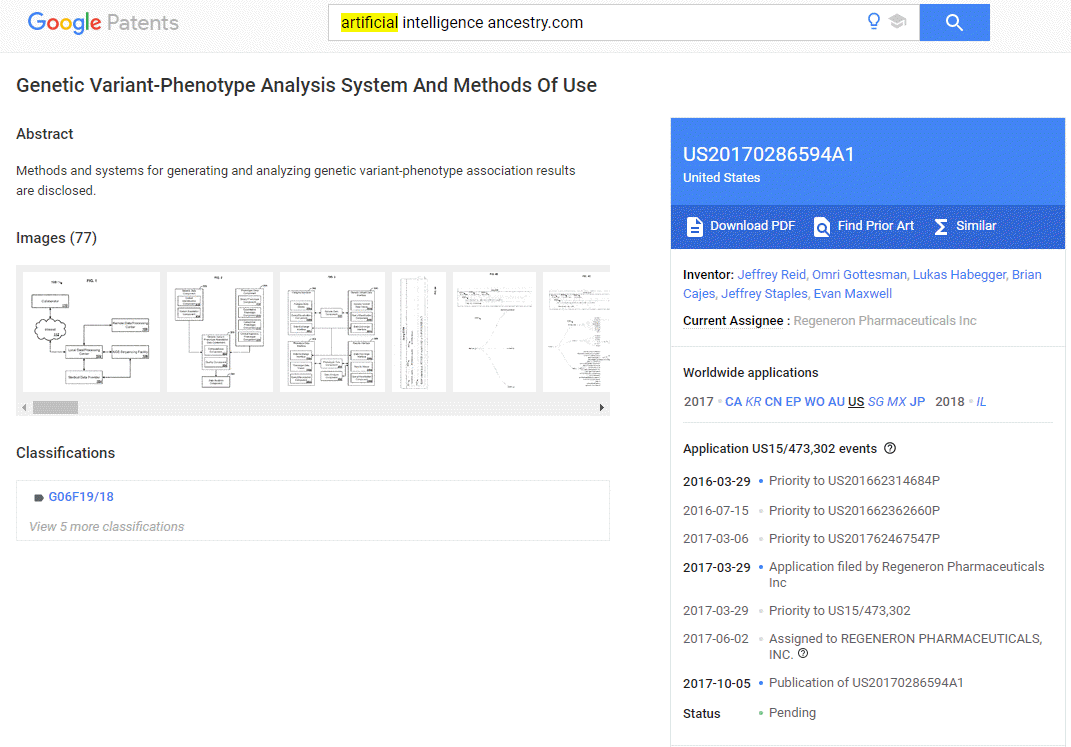
Patent search result: a pending patent involving AI and DNA by Regeneron Pharmaceuticals, Inc.
AI now makes our genealogical research and family tree data just as valuable to others outside of genealogy.
This begs the question, who else might be interested in our family tree research and data?
Who Is Interested in Your Genealogy Data
One answer to this question is academic researchers. During my research on this subject The Record Linking Lab at Brigham Young University surfaced as just one example. It’s run by a BYU Economics Professor who published a research paper on their work called Combining Family History and Machine Learning to Link Historical Records. The paper was co-authored with a Notre Dame Economics and Women’s Studies professor.
In this example, their goals are driven by economic, social, and political issues rather than genealogy. Their published paper does offer an eye-opening look at the value that those outside the genealogy community place on all of the personal data we’re collecting and the genealogical records we are linking. Our work is about our ancestors, and therefore it is about ourselves. Even if living people are not named on our tree, they are named in the records we are linking to it. We are making it all publicly available.
In the past, historical records like birth and death, military and the census have been available to these researchers, but on an individual basis. This made them difficult to work with. Academic (and industry) researchers couldn’t easily follow these records for individual people, families, and generations of families through time in order to draw meaningful conclusions. But for the first-time machine learning is being applied to online genealogy research data making it possible to link these records to living and deceased individuals and their families.
It’s a lot to think about, but it’s important because it is our family history data. We need to understand how our data is being used inside and outside the genealogy sandbox.
Answers to Your Live Chat Questions About AI
One of the advantages of tuning into the live broadcast of each Elevenses with Lisa show is participating in the Live Chat and asking your questions.

www.GenealogyGems.com/Elevenses
From Linda J: What about all the “people search” sites (not genealogy) that have all, or a lot of, our personal date?
Lisa’s Answer: My understanding is that much of the information provided on many of the “people search” websites comes from public information. So while the information is much easier to access these days, it’s been publicly available for years. That information isn’t as accessible to projects like the one discussed in this episode because those websites don’t make their Application Programming Interface (known as API) publicly available like FamilySearch does.
From Doug H: Wouldn’t that potentially find errors in our trees?
Lisa’s Answer: Yes.
From Sheryl T: Do these academic researchers have access to the living people on the trees? Or are those protected from them as it is to the public?
Lisa’s Answer: They have access to all information attached to people marked as “Living Person.” Therefore, if the attached record names them, their identity would then be known. Click a hint on your tree at Ancestry for example, and the found records clearly spell out the name of the person they believe is your “Living” person.
From Nancy M: How long do the show notes stay available? am looking for Google Books two weeks ago and last week’s Allen Co Library.
Lisa’s Answer: The show notes remain available until the episode is archived in Premium Membership. You can find all of the currently available free Elevenses with Lisa episodes on our website in the menu under VIDEOS click Elevenses with Lisa.
Nannie A: I heard a rumor that Ancestry .com has been sold. Do you know if that’s true?
Lisa’s Answer: Yes, they were sold again this year. Read:
Private equity firm Blackstone Group Inc. buying Ancestry.com for $4.7 billion
Private equity wants to own your DNA by CBS News.
Resources
Get My Free Genealogy Gems Newsletter – click here.
Bonus Download exclusively for Premium Members: Download the show notes handout.
Become a Genealogy Gems Premium Member today.
Missing Census or Missing Family: Legacy Tree Genealogists Answer
So, you think there might be a missing census page? Whether it’s a missing census or a missing family, my special guest, professional genealogist Kate Eakman from Legacy Tree Genealogists has strategies to help you figure it out. She has just the answers you need to find your ‘missing’ family.
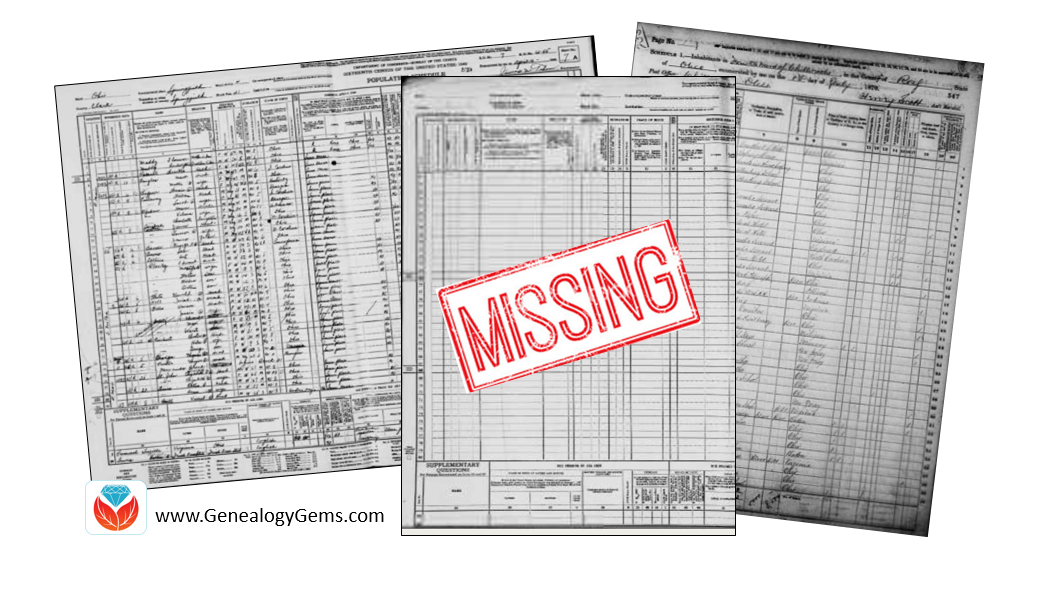
A Genealogy Gems reader doing genealogy research in New Jersey has lost her family! Well not literally, but she can’t find them in the 1940 U.S. Census. Here’s the email I recently received from her:
I am having a problem finding my mother and grandparents in the 1940 census. My grandfather, William Charles Opfer, was born on October 15 1900. I can find him in the 1930 census living in Glouescter Township, (Unincorporated Grenloch) Camden County, New Jersey. He is living with his wife Kathryn (Katharine) Opfer and three children: William C Jr, Robert, and Nancy (my mother).
When I search the 1940 census on Ancestry nothing shows up. So I went to the government web site and converted the 1930 Enumeration District to the 1940 Enumeration District. The 1940 Enumeration Districts were 4-57, 4-58, and 4-61. I then went through all of the pages for each of the districts looking for William C. Opfer. I did this on Ancestry, Family Search, and NARA. No William C. Opfer.
I then went back to the 1930 census and looked at his neighbors. I searched for each of the 13 heads-of-household neighbors from the 1930 census. Two had moved 1940 and I found them. I could not find the other neighbors in the 1940 census. I am wondering if a page from the 1940 census did not get scanned? Is there somewhere else I could look?
Missing Census Answers from Kate Eakman, Legacy Tree Genealogists
First, let me say how impressed I am with this Gem’s research and her dedication to finding this census report. She has made some very thorough searches and performed a number of advanced genealogical techniques in her quest for the 1940 U.S. Census page. It hardly seems fair that all that work didn’t yield the success she surely earned.
The government website she referenced is the National Archives 1940 Census page. The use of the page “1930 Records Search” allowed her to simply locate her grandfather in the 1930 U.S. Census. Then, by clicking a few buttons, discover the corresponding enumeration districts (ED) for the 1930 ED in which he and his family lived: 4-57, 4-58, and 4-61.

I, too, have scrolled through page after page searching for that one elusive name and we know how tedious that task can be! Using three different sites was a good strategy and one that we employ ourselves here at Legacy Tree Genealogists. Different images might be easier or more difficult to read, although in the case of these three EDs, the copies seemed to be uniformly easy to read.
The first two EDs were for Blackwood, an unincorporated part of Camden County, New Jersey. The third one was for the Lakeland Tuberculosis Hospital, unlikely to have housed the entire family, but certainly worth looking through in case one Opfer was a patient there.
ED 4-58 had an interesting variation at the end of the report. The last two pages were not 15A and 15B, as would be expected, but were 61A and 61B. This indicates these households were enumerated at a later date than were their neighbors. Because federal law requires every household to be counted, and because not everyone was at home when the enumerator arrived, the enumerator had to return on a different day and attempt to gather the necessary information for those families. They were recorded separately, beginning with page 61A.
People living in hotels, trailer camps, and other places normally designed for single-night stays were enumerated a week after the initial enumeration and those pages are numbered beginning with 81A. Not every ED has a 61 or an 81 page, but if you see one, now you know why the page numbers suddenly changed so dramatically.
The writer’s use of Elizabeth Shown Mills’ FAN Club was an excellent idea, too. FAN, an acronym for Friends, Associates, and Neighbors, takes advantage of the fact that people, in general, tend to remain geographically close to the people they know. [Read more about this in our post, “The Genealogy FAN Club Principle Overcomes Genealogy Brick Walls“] If a portion of a community moves, they tend to move together and relocate in the same general area of their new location. Her instincts to use this tool were excellent, even if they did not produce the desired results. This falls under the heading of “reasonably exhaustive research” and should always be included when someone, or in this case something, can’t be found, but should be there.
The fact that the researcher was able to locate only two of those neighbors could be explained, in part, by the fact that so many were in their 60s, 70s, and even 90s in 1930. They simply may have passed away in the intervening ten years. Another explanation, particularly for the working families, is that the Great Depression caused many families to move in order to find employment.
This may have been true for the Opfers. We noticed in 1930, William was employed as a supervisor for Reading Transportation. While supervisors were important to the operation of any transportation company, it is possible William found himself unemployed, as was true for millions of other Americans. If that happened, he and his family could have moved anywhere in the United States in an effort to find work. Alternatively, William may have left to find work while Kathryn and the children lived by themselves in reduced circumstances, or with family or friends.
To this end, I searched for William and Kathryn, and then each of the three children individually, in the hope of locating one or more family members. Using the “less is more” strategy which is often an important part of genealogical research, I searched with and without the family members’ ages, places of birth, and other family member’s names. Because the surname “Opfer” might have been misheard by the enumerator or grossly misspelled, I even searched for the various members of the family with no surname. Since we did not know where the family may have lived between 1930 and 1944, we included all of New Jersey, Delaware (the home state of Kathryn), as well as neighboring Pennsylvania and New York in our searches. The lack of positive results meant we needed to expand our search to the Eastern seaboard, and then the entire United States.
We also identified the names of William’s and Kathryn’s parents, William and Sallie Opfer and Raymond and Corrine Mason, and searched their households and neighborhoods for William and Kathryn. They were not there. Walter, William’s younger brother, was not hosting the family, either.
The writer had asked if it was possible that a page from the 1940 U.S. Census did not get scanned. Since the 1940 census has only been available for four years, it is still possible, although not probable, that there are one or more pages missing unbeknownst to anyone. Our research revealed only a few pages from a couple EDs in Ohio and South Dakota that were missing from the FamilySearch collection. There is no indication anywhere that there are missing pages from New Jersey. In addition, the pages in the three possible EDs for the Opfers were all included and in the correct numerical order, with no indication of any missing pages at the end. Therefore, I think we must conclude that missing pages do not explain the Opfer family’s disappearance.
Other Databases to Help
There are two other databases which might provide some insight into the location of the Opfer family. The first is the set of 1942 World War II draft registration cards. All men between the ages of 18 and 65 were required to register for this draft. The draft registration cards would have included the address at which William lived in 1942; however, there was no card for a man named William Opfer (or with only the surname “Opfer”) born between 1895 and 1905.
The final search was the database of city directories. A poorly-indexed city directory reported the Opfers lived in Haddonfield, New Jersey in 1943, but there are two directories contained in the same book, and the listing was actually for 1947. It reported William and Katherine lived at 209 Washington Avenue with their children William and his wife, Robert, and Nancy. William’s brother, Walter, and his wife Edith lived nearby. Unfortunately, the search for them in 1940 revealed that 79-year-old widower William Pape lived at that address with his household servants who were not the Opfer’s.
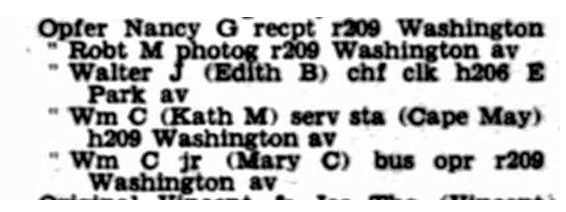
The William Opfer family in Haddonfield, New Jersey in 1947.Photo courtesy Ancestry.
Although the turmoil and upheaval of the Great Depression meant families were scattered, and it would have been easy to miss enumerating many households in the mid-1930s, by 1940 the U.S. was recovering from the effects of the Depression. Some agencies, such as the Works Progress Administration (WPA) and the CCC (Civilian Conservation Corps), were in place to provide work for men. Many war-related industries on both coasts were revived by the Allies’ efforts to stop Hitler.
In other words, there should have been work and stability for the Opfer family by 1940, and they ought to have appeared in a census report. The evidence of the 1930 census and the 1947 city directory strongly suggest they remained in or close to New Jersey, but all of the efforts to locate them have failed to yield positive results.
One Last Scenario
One possible scenario which would explain the Opfers apparent absence from the 1940 census is a simple one: perhaps the family was in the process of moving from one location to another in the month of April when the census was enumerated. Although the census was supposed to be enumerated on 1 April, the reality is that it was simply impossible to knock on every door and obtain the necessary information in one day. Some enumeration districts were fully counted by the 4th of the month. Other places were not completed until the 30th. This was true even in the same town.
If the Opfers had moved across the street from 206 Washington Avenue to 209 Washington Avenue in Haddonfield, for instance, between the 5th and the 14th of April, they would have moved from one enumeration district to another. Because the 209 Washington Avenue address had been enumerated on 4 April, they would not have been counted in that new location. And, because the 206 Washington Avenue address was not enumerated until the 15th of the month, they would not have been included in that EDs census report. We have seen this happen in the reverse and a family was enumerated twice because they moved during the enumeration, so it certainly could have happened the other way around. This is the only explanation we can find to explain the absence of the Opfers from the 1940 U.S. Census.
More About Kate Eakman at Legacy Tree Genealogists and SAVE $100!
 Kate Eakman grew up hearing Civil War stories at her father’s knee and fell in love with history and genealogy at an early age. With a master’s degree in history and over 20 years experience as a genealogist, Kate has worked her magic on hundreds of family trees and narratives.
Kate Eakman grew up hearing Civil War stories at her father’s knee and fell in love with history and genealogy at an early age. With a master’s degree in history and over 20 years experience as a genealogist, Kate has worked her magic on hundreds of family trees and narratives.
Areas of expertise:
-Native American Genealogy
-U.S. Civil War & Victorian America
-Narrative Biographies
-Irish Genealogy
The team of expert genealogists at Legacy Tree Genealogists can help bust through your brick walls. They do the research and you enjoy the discoveries!



